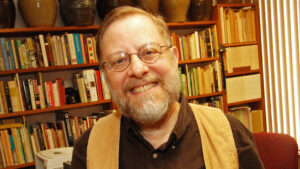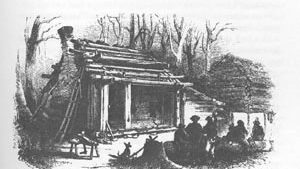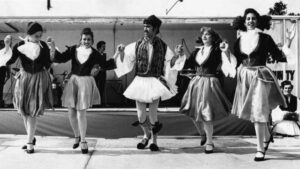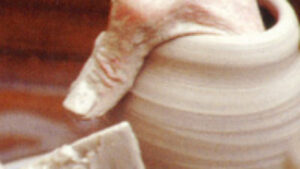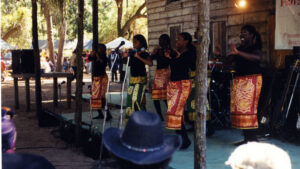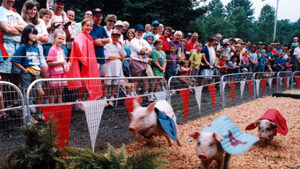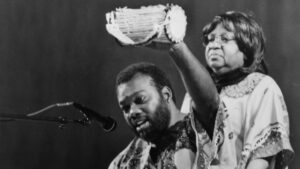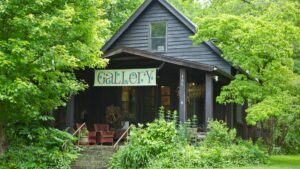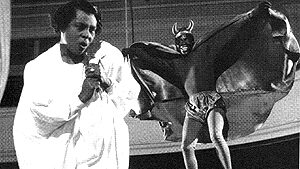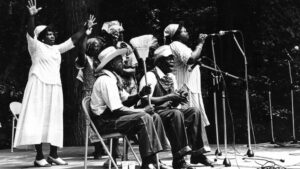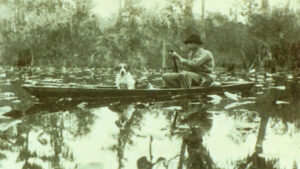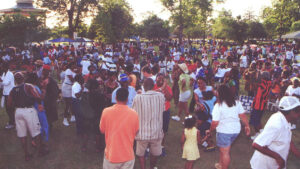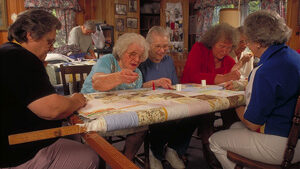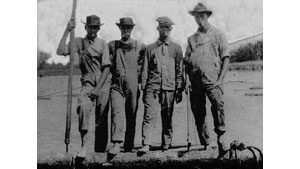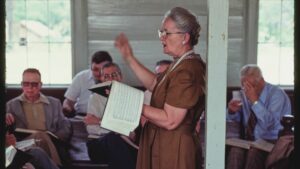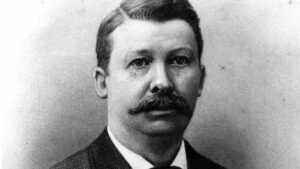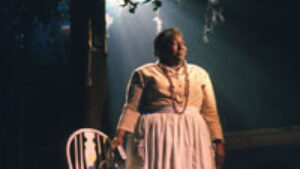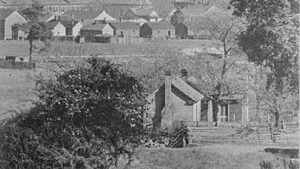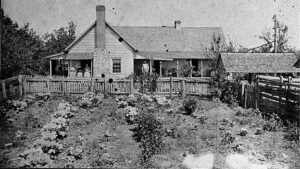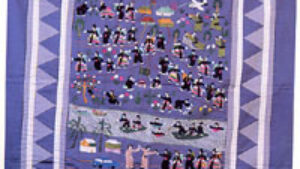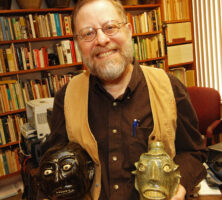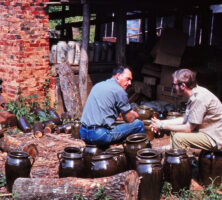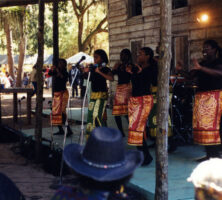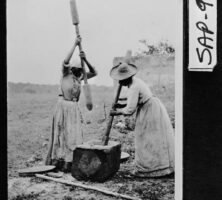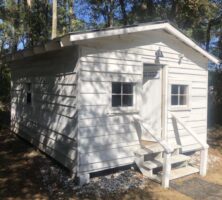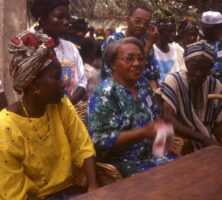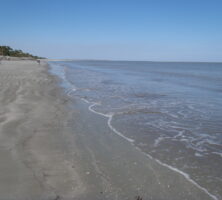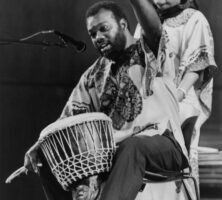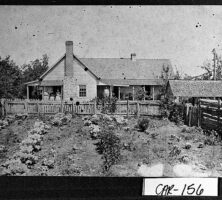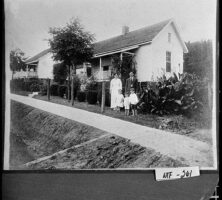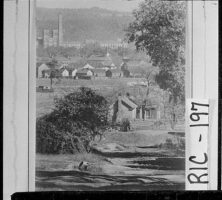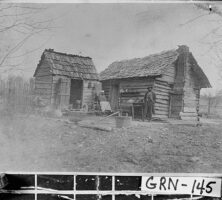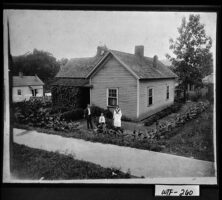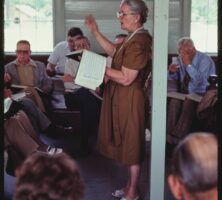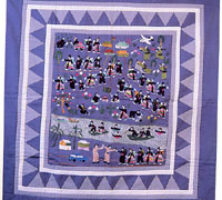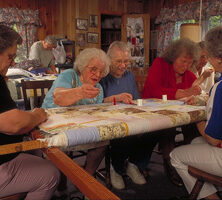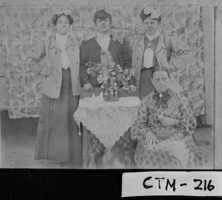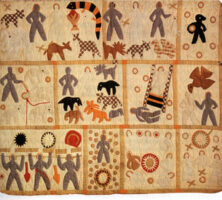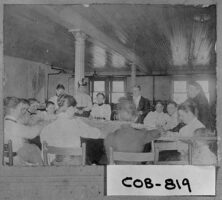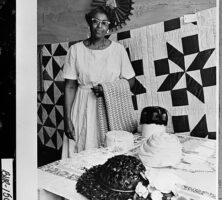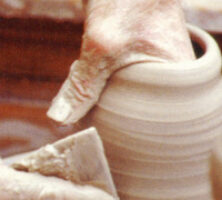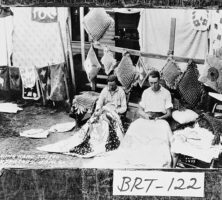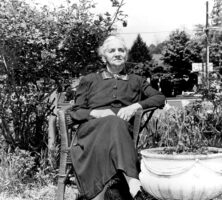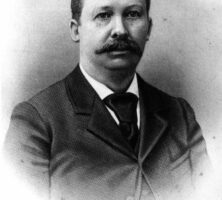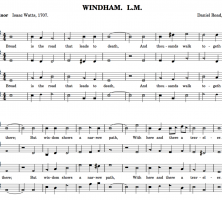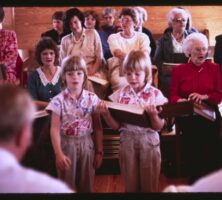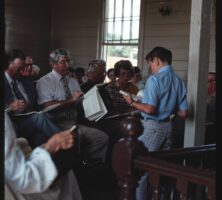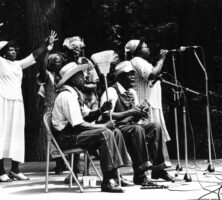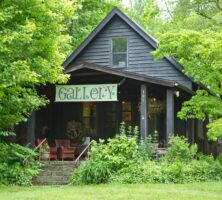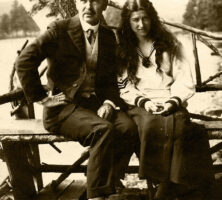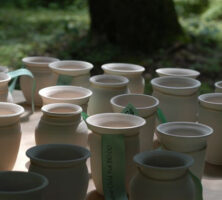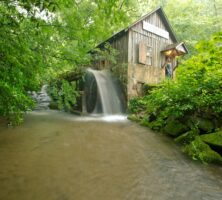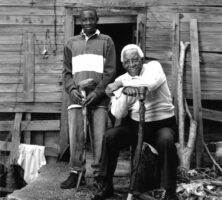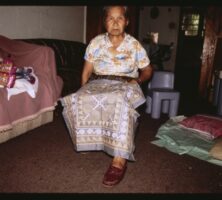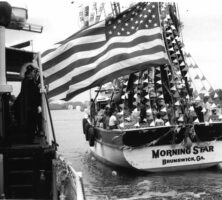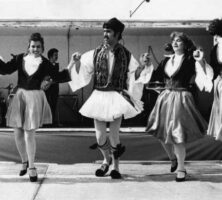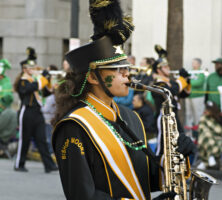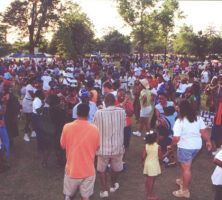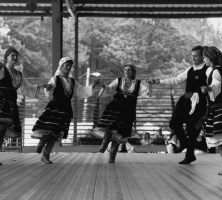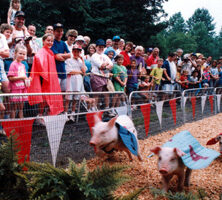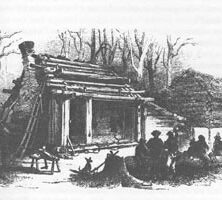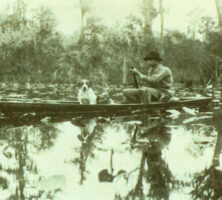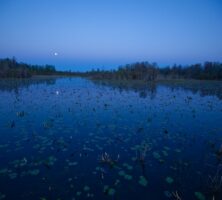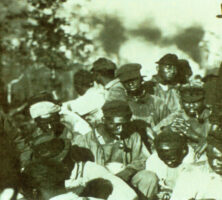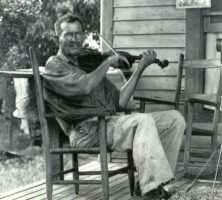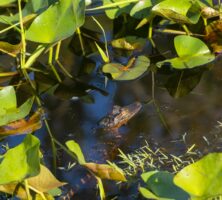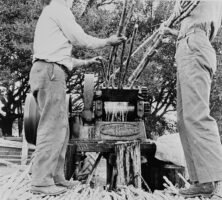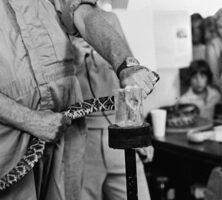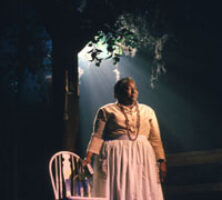The New Georgia Encyclopedia is supported by funding from A More Perfect Union, a special initiative of the National Endowment for the Humanities.
A folklorist and professor of English at Georgia State University in Atlanta, John A. Burrison has helped shape an entire academic field of specialty, that of folk pottery. He holds a couple of face "jugs."
Courtesy of John Burrison. Photograph by Carolyn Richardson
The New Georgia Encyclopedia does not hold the copyright for this media resource and can neither grant nor deny permission to republish or reproduce the image online or in print. All requests for permission to publish or reproduce the resource must be submitted to the rights holder.
Mossy Creek potter Lanier Meaders (left) with folklorist John A. Burrison in 1970. The painted vases on the kiln were made by Lanier's mother, Arie Meaders. The Meaders family is one of the best-known traditional potter families in northeast Georgia.
Courtesy of John Burrison. Photograph by Dick Pillsbury
The New Georgia Encyclopedia does not hold the copyright for this media resource and can neither grant nor deny permission to republish or reproduce the image online or in print. All requests for permission to publish or reproduce the resource must be submitted to the rights holder.
Singers perform during the Sapelo Island Cultural Day, held each October on the island. The festival celebrates the songs, stories, dances, and food of the Geechee and Gullah culture, which developed on the Sea Islands among enslaved West Africans between 1750 and 1865.
Photograph by Jennifer Cruse Sanders
The New Georgia Encyclopedia does not hold the copyright for this media resource and can neither grant nor deny permission to republish or reproduce the image online or in print. All requests for permission to publish or reproduce the resource must be submitted to the rights holder.
In the same manner as their enslaved ancestors, women on Sapelo Island hull rice with a mortar and pestle, circa 1925. Language and cultural traditions from West Africa were retained in the Geechee culture that developed in the Sea Islands.
Courtesy of Georgia Archives, Vanishing Georgia, #
sap093.
The New Georgia Encyclopedia does not hold the copyright for this media resource and can neither grant nor deny permission to republish or reproduce the image online or in print. Requests for permission to publish or reproduce the resource should be submitted to the Georgia Archives.
The New Georgia Encyclopedia does not hold the copyright for this media resource and can neither grant nor deny permission to republish or reproduce the image online or in print. All requests for permission to publish or reproduce the resource must be submitted to the rights holder.
The New Georgia Encyclopedia does not hold the copyright for this media resource and can neither grant nor deny permission to republish or reproduce the image online or in print. All requests for permission to publish or reproduce the resource must be submitted to the rights holder.
Praise houses were built on plantations by enslaved people for worship services. These services often included the ring shout, in which rhythmic hand clapping and counterclockwise dancing were performed to spirituals.
Image from Richard N Horne
The New Georgia Encyclopedia does not hold the copyright for this media resource and can neither grant nor deny permission to republish or reproduce the image online or in print. All requests for permission to publish or reproduce the resource must be submitted to the rights holder.
Baindu Jabati (left) and Mary Moran were the only two women to remember a Mende funeral song performed as part of the village tradition in Senehun Ngola, Sierra Leone. The song was passed down through Moran's family in Georgia from her enslaved ancestors, who were related to Jabati's ancestors in Sierra Leone.
Photograph by Sharon Maybarduk
The New Georgia Encyclopedia does not hold the copyright for this media resource and can neither grant nor deny permission to republish or reproduce the image online or in print. All requests for permission to publish or reproduce the resource must be submitted to the rights holder.
The Georgia Sea Islands are the site of the unique Geechee and Gullah culture, which retains ethnic traditions from West Africa brought to America during the years of the Atlantic slave trade. Although elements of the culture persist, its survival is threatened by development on the islands.
Photograph by WIDTTF
The New Georgia Encyclopedia does not hold the copyright for this media resource and can neither grant nor deny permission to republish or reproduce the image online or in print. All requests for permission to publish or reproduce the resource must be submitted to the rights holder.
Tony Merrell drums during a performance of the Georgia Sea Island Singers, as fellow member Frankie Sullivan Quimby looks on. The singers maintain a tradition, begun around 1900, of sharing the Gullah culture through performances and educational programs.
Courtesy of Georgia Sea Island Singers
The New Georgia Encyclopedia does not hold the copyright for this media resource and can neither grant nor deny permission to republish or reproduce the image online or in print. All requests for permission to publish or reproduce the resource must be submitted to the rights holder.
The New Georgia Encyclopedia does not hold the copyright for this media resource and can neither grant nor deny permission to republish or reproduce the image online or in print. All requests for permission to publish or reproduce the resource must be submitted to the rights holder.
The New Georgia Encyclopedia does not hold the copyright for this media resource and can neither grant nor deny permission to republish or reproduce the image online or in print. All requests for permission to publish or reproduce the resource must be submitted to the rights holder.
Members of a family pose on the porch of their farmhouse in Carroll County, ca. 1870-99. Kitchen gardens, such as the one in the foreground, were traditionally tended by women.
Courtesy of Georgia Archives, Vanishing Georgia, #
car156.
The New Georgia Encyclopedia does not hold the copyright for this media resource and can neither grant nor deny permission to republish or reproduce the image online or in print. Requests for permission to publish or reproduce the resource should be submitted to the Georgia Archives.
The New Georgia Encyclopedia does not hold the copyright for this media resource and can neither grant nor deny permission to republish or reproduce the image online or in print. All requests for permission to publish or reproduce the resource must be submitted to the rights holder.
A Dalton family poses in front of its mill house in the Chattanooga Avenue area in 1919. Textile mills in Dalton held contests to determine the most attractive yards of the mill homes, and this yard was one of the winners.
Courtesy of Georgia Archives, Vanishing Georgia, #
wtf261.
The New Georgia Encyclopedia does not hold the copyright for this media resource and can neither grant nor deny permission to republish or reproduce the image online or in print. Requests for permission to publish or reproduce the resource should be submitted to the Georgia Archives.
The New Georgia Encyclopedia does not hold the copyright for this media resource and can neither grant nor deny permission to republish or reproduce the image online or in print. All requests for permission to publish or reproduce the resource must be submitted to the rights holder.
Mill villages were a prevalent form of vernacular architecture in Georgia during the industrial era. King Mill appears in the background of this view of Augusta, ca. 1912 to 1915.
Courtesy of Georgia Archives, Vanishing Georgia, #
ric197.
The New Georgia Encyclopedia does not hold the copyright for this media resource and can neither grant nor deny permission to republish or reproduce the image online or in print. Requests for permission to publish or reproduce the resource should be submitted to the Georgia Archives.
The owners of this cabin appear in front of their home in Union Point, Greene County, ca. 1900. The timber for such cabins was usually cut and hewn on the building site.
Courtesy of Georgia Archives, Vanishing Georgia, #
grn145.
The New Georgia Encyclopedia does not hold the copyright for this media resource and can neither grant nor deny permission to republish or reproduce the image online or in print. Requests for permission to publish or reproduce the resource should be submitted to the Georgia Archives.
A family poses in front of its mill house, located in the Chattanooga Avenue area of Dalton, in 1919 after winning a contest sponsored by a textile mill for the most attractive yard.
Courtesy of Georgia Archives, Vanishing Georgia, #wtf260.
The New Georgia Encyclopedia does not hold the copyright for this media resource and can neither grant nor deny permission to republish or reproduce the image online or in print. Requests for permission to publish or reproduce the resource should be submitted to the Georgia Archives.
The New Georgia Encyclopedia does not hold the copyright for this media resource and can neither grant nor deny permission to republish or reproduce the image online or in print. All requests for permission to publish or reproduce the resource must be submitted to the rights holder.
The New Georgia Encyclopedia does not hold the copyright for this media resource and can neither grant nor deny permission to republish or reproduce the image online or in print. All requests for permission to publish or reproduce the resource must be submitted to the rights holder.
The New Georgia Encyclopedia does not hold the copyright for this media resource and can neither grant nor deny permission to republish or reproduce the image online or in print. All requests for permission to publish or reproduce the resource must be submitted to the rights holder.
First published in 1844, The Sacred Harp songbook has helped to promote the style of singing known as "Sacred Harp," "shape-note," or "fasola" singing.
Courtesy of Library of Congress, Prints and Photographs Division
The New Georgia Encyclopedia does not hold the copyright for this media resource and can neither grant nor deny permission to republish or reproduce the image online or in print. All requests for permission to publish or reproduce the resource must be submitted to the rights holder.
The New Georgia Encyclopedia does not hold the copyright for this media resource and can neither grant nor deny permission to republish or reproduce the image online or in print. All requests for permission to publish or reproduce the resource must be submitted to the rights holder.
A statue of Brer Rabbit, a major character in the Uncle Remus tales by Joel Chandler Harris, stands in front of the Putnam County Courthouse. Harris's work, particularly his animal tales, brought African American folklore into the public spotlight.
Image from Mdxi
The New Georgia Encyclopedia does not hold the copyright for this media resource and can neither grant nor deny permission to republish or reproduce the image online or in print. All requests for permission to publish or reproduce the resource must be submitted to the rights holder.
The New Georgia Encyclopedia does not hold the copyright for this media resource and can neither grant nor deny permission to republish or reproduce the image online or in print. All requests for permission to publish or reproduce the resource must be submitted to the rights holder.
The New Georgia Encyclopedia does not hold the copyright for this media resource and can neither grant nor deny permission to republish or reproduce the image online or in print. All requests for permission to publish or reproduce the resource must be submitted to the rights holder.
The New Georgia Encyclopedia does not hold the copyright for this media resource and can neither grant nor deny permission to republish or reproduce the image online or in print. All requests for permission to publish or reproduce the resource must be submitted to the rights holder.
A story cloth by textile artist and Hmong refugee May Tong Moua depicts Hmong villagers fleeing Communist forces (upper right-hand corner) in Laos and crossing the Mekong River to arrive at a refugee camp in Thailand. A resident of Lilburn, May Tong Moua is among a number of Hmong refugees who resettled in DeKalb and Gwinnett counties. The story cloth, made in 1991, is housed at the Atlanta History Center.
Courtesy of Atlanta History Center.
The New Georgia Encyclopedia does not hold the copyright for this media resource and can neither grant nor deny permission to republish or reproduce the image online or in print. Requests for permission to publish or reproduce the resource should be submitted to the Atlanta History Center.
Georgia quilt makers, such as the Busy Bee Quilting Club in Dalton, continue to make quilts for the same reasons as earlier generations: to engage in a satisfying creative activity, to produce beautiful objects of lasting value for family and friends, and to make connections with other people.
Courtesy of Georgia Department of Economic Development.
The New Georgia Encyclopedia does not hold the copyright for this media resource and can neither grant nor deny permission to republish or reproduce the image online or in print. Requests for permission to publish or reproduce the resource may need to be submitted to the Georgia Department of Economic Development.
A Chatham County quilt-making group, circa 1900, included (left to right) Avie Wheeler, Leona Wheeler, Sarah Wheeler, and Mary Jane Wheeler (seated). These women made the quilt that hangs in the background.
Courtesy of Georgia Archives, Vanishing Georgia, #
ctm216.
The New Georgia Encyclopedia does not hold the copyright for this media resource and can neither grant nor deny permission to republish or reproduce the image online or in print. Requests for permission to publish or reproduce the resource should be submitted to the Georgia Archives.
Harriet Powers finished her Bible Quilt around 1886 in Athens. The third panel in the second row depicts the story of Jacob's dream, when "he lay on the ground." Enslaved African Americans identified with Jacob, for he was homeless, hunted, and weary of his journey.
Courtesy of National Museum of American History, Smithsonian Institution
The New Georgia Encyclopedia does not hold the copyright for this media resource and can neither grant nor deny permission to republish or reproduce the image online or in print. All requests for permission to publish or reproduce the resource must be submitted to the rights holder.
Members of the Ladies Aid Society of Marietta at a First Baptist Church quilting in 1904.
Courtesy of Georgia Archives, Vanishing Georgia, #
cob819.
The New Georgia Encyclopedia does not hold the copyright for this media resource and can neither grant nor deny permission to republish or reproduce the image online or in print. Requests for permission to publish or reproduce the resource should be submitted to the Georgia Archives.
The New Georgia Encyclopedia does not hold the copyright for this media resource and can neither grant nor deny permission to republish or reproduce the image online or in print. All requests for permission to publish or reproduce the resource must be submitted to the rights holder.
An unidentified Waynesboro woman displays her handiwork at a show sponsored by the Economic Opportunity Agency, circa 1968.
Courtesy of Georgia Archives, Vanishing Georgia, #bur150.
The New Georgia Encyclopedia does not hold the copyright for this media resource and can neither grant nor deny permission to republish or reproduce the image online or in print. Requests for permission to publish or reproduce the resource should be submitted to the Georgia Archives.
The New Georgia Encyclopedia does not hold the copyright for this media resource and can neither grant nor deny permission to republish or reproduce the image online or in print. All requests for permission to publish or reproduce the resource must be submitted to the rights holder.
Georgia potters picked up the European approach that uses a potter's wheel, kiln, and glazes in the early 1800s. Here a potter forms clay with his hands as the clay rotates on a potter's wheel.
Photograph by Fred Fussell
The New Georgia Encyclopedia does not hold the copyright for this media resource and can neither grant nor deny permission to republish or reproduce the image online or in print. All requests for permission to publish or reproduce the resource must be submitted to the rights holder.
The New Georgia Encyclopedia does not hold the copyright for this media resource and can neither grant nor deny permission to republish or reproduce the image online or in print. All requests for permission to publish or reproduce the resource must be submitted to the rights holder.
The New Georgia Encyclopedia does not hold the copyright for this media resource and can neither grant nor deny permission to republish or reproduce the image online or in print. All requests for permission to publish or reproduce the resource must be submitted to the rights holder.
The New Georgia Encyclopedia does not hold the copyright for this media resource and can neither grant nor deny permission to republish or reproduce the image online or in print. All requests for permission to publish or reproduce the resource must be submitted to the rights holder.
The New Georgia Encyclopedia does not hold the copyright for this media resource and can neither grant nor deny permission to republish or reproduce the image online or in print. All requests for permission to publish or reproduce the resource must be submitted to the rights holder.
Clete Meaders talks about the history of the Meaders family pottery business.
Video by Darby Carl Sanders and Josh Borger, New Georgia Encyclopedia
The New Georgia Encyclopedia does not hold the copyright for this media resource and can neither grant nor deny permission to republish or reproduce the image online or in print. All requests for permission to publish or reproduce the resource must be submitted to the rights holder.
Lin Craven makes a ring jug and discusses why she became a potter.
Video by Darby Carl Sanders, New Georgia Encyclopedia
The New Georgia Encyclopedia does not hold the copyright for this media resource and can neither grant nor deny permission to republish or reproduce the image online or in print. All requests for permission to publish or reproduce the resource must be submitted to the rights holder.
Folk potter Lin Craven demonstrates as she explains how to make a ring jug.
Video by Darby Carl Sanders, New Georgia Encyclopedia
The New Georgia Encyclopedia does not hold the copyright for this media resource and can neither grant nor deny permission to republish or reproduce the image online or in print. All requests for permission to publish or reproduce the resource must be submitted to the rights holder.
Mrs. J. A. Green and her son, Allen Burton, make tufted bedspreads on U.S. Highway 41 in Bartow County, 1933. Green was one of the first in the county to make chenille bedspreads.
Courtesy of Georgia Archives, Vanishing Georgia, #brt122.
The New Georgia Encyclopedia does not hold the copyright for this media resource and can neither grant nor deny permission to republish or reproduce the image online or in print. Requests for permission to publish or reproduce the resource should be submitted to the Georgia Archives.
The New Georgia Encyclopedia does not hold the copyright for this media resource and can neither grant nor deny permission to republish or reproduce the image online or in print. All requests for permission to publish or reproduce the resource must be submitted to the rights holder.
Catherine Evans Whitener brought back the handcraft of tufting in the 1890s, which played an important role in the economic development of northwest Georgia as its popularity grew.
Courtesy of Shaw Industries, Inc.
The New Georgia Encyclopedia does not hold the copyright for this media resource and can neither grant nor deny permission to republish or reproduce the image online or in print. All requests for permission to publish or reproduce the resource must be submitted to the rights holder.
Betty Ann Wylie explains that stories are told not only through words but also through "the paralanguage."
Video by Darby Carl Sanders, New Georgia Encyclopedia
The New Georgia Encyclopedia does not hold the copyright for this media resource and can neither grant nor deny permission to republish or reproduce the image online or in print. All requests for permission to publish or reproduce the resource must be submitted to the rights holder.
The New Georgia Encyclopedia does not hold the copyright for this media resource and can neither grant nor deny permission to republish or reproduce the image online or in print. All requests for permission to publish or reproduce the resource must be submitted to the rights holder.
B. J. Abraham demonstrates how she assumes different characters by using different voices when she's telling a story.
Video by Darby Carl Sanders, New Georgia Encyclopdedia
The New Georgia Encyclopedia does not hold the copyright for this media resource and can neither grant nor deny permission to republish or reproduce the image online or in print. All requests for permission to publish or reproduce the resource must be submitted to the rights holder.
B. J. Abraham says she feels that storytelling is a "low-tech art in a high-tech world."
Video by Darby Carl Sanders, New Georgia Encyclopedia
The New Georgia Encyclopedia does not hold the copyright for this media resource and can neither grant nor deny permission to republish or reproduce the image online or in print. All requests for permission to publish or reproduce the resource must be submitted to the rights holder.
Joel Chandler Harris took his work as a fiction writer seriously, and he honed his craft considerably in the course of publishing seven volumes of short stories (in addition to the Uncle Remus tales) and three more novels.
The New Georgia Encyclopedia does not hold the copyright for this media resource and can neither grant nor deny permission to republish or reproduce the image online or in print. Requests for permission to publish or reproduce the resource should be submitted to the Hargrett Manuscript and Rare Book Library at the University of Georgia.
The shape-note system in The Sacred Harp uses a different shape to represent each of the four syllables in the musical scale: a triangle (fa), a circle (sol), a rectangle (la), and a diamond (mi).
The tune "Windham" as it appears in The Sacred Harp, 1911 edition. Image from Wikimedia.
The New Georgia Encyclopedia does not hold the copyright for this media resource and can neither grant nor deny permission to republish or reproduce the image online or in print. All requests for permission to publish or reproduce the resource must be submitted to the rights holder.
Gapped scales (having less than the usual seven notes) and unusual harmonies help account for this traditional music's characteristic sound. Also unique is the doubling of two parts, both men and women singing tenor and treble. Untrained voices prevail, so the singing sounds loud and exhilarating.
Courtesy of Georgia Council for the Arts, Georgia Traditional Arts Research Collection, Abraham Baldwin Agricultural College Libraries.
The New Georgia Encyclopedia does not hold the copyright for this media resource and can neither grant nor deny permission to republish or reproduce the image online or in print. Requests for permission to publish or reproduce the resource should be submitted to the Georgia Council for the Arts.
The sound of Sacred Harp may vary a bit from region to region, and white singers have different styles from African American singers. But regardless of location or race, Sacred Harp sounds unlike academic choral singing or gospel singing, in which melody dominates and harmony embellishes and supports it.
Courtesy of Library of Congress, Prints and Photographs Division
The New Georgia Encyclopedia does not hold the copyright for this media resource and can neither grant nor deny permission to republish or reproduce the image online or in print. All requests for permission to publish or reproduce the resource must be submitted to the rights holder.
The McIntosh County Shouters, seen here performing at National Folk Festival, Wolf Trap Farm, Virginia, have helped preserve the southeastern ring shout, one of the oldest African American performance traditions in the country.
Courtesy of Margo Rosenbaum
The New Georgia Encyclopedia does not hold the copyright for this media resource and can neither grant nor deny permission to republish or reproduce the image online or in print. All requests for permission to publish or reproduce the resource must be submitted to the rights holder.
The New Georgia Encyclopedia does not hold the copyright for this media resource and can neither grant nor deny permission to republish or reproduce the image online or in print. All requests for permission to publish or reproduce the resource must be submitted to the rights holder.
The New Georgia Encyclopedia does not hold the copyright for this media resource and can neither grant nor deny permission to republish or reproduce the image online or in print. All requests for permission to publish or reproduce the resource must be submitted to the rights holder.
Exterior view of the Hambidge Center Gallery. The gallery is one way the center provides public accessibility.
Courtesy of Explore Georgia, Photograph by Ralph Daniel.
The New Georgia Encyclopedia does not hold the copyright for this media resource and can neither grant nor deny permission to republish or reproduce the image online or in print. Requests for permission to publish or reproduce the resource may need to be submitted to Explore Georgia.
Mary Hambidge founded the Jay Hambidge Art Foundation in 1934, naming it after her late partner. The foundation, later the Hambidge Center, was incorporated ten years later as a nonprofit organization for educational and scientific purposes.
Courtesy of Hambidge Center for Creative Arts and Sciences
The New Georgia Encyclopedia does not hold the copyright for this media resource and can neither grant nor deny permission to republish or reproduce the image online or in print. All requests for permission to publish or reproduce the resource must be submitted to the rights holder.
An artist at work in the Hambidge Center studio.
Courtesy of Explore Georgia, Photograph by Ralph Daniel.
The New Georgia Encyclopedia does not hold the copyright for this media resource and can neither grant nor deny permission to republish or reproduce the image online or in print. Requests for permission to publish or reproduce the resource may need to be submitted to Explore Georgia.
Pottery made in the "U Do Raku" workshop, which is an annual event at the Hambidge Center. Raku describes the unique process of kiln-firing the hand-thrown pottery before removing it to "reduce" in a cooler environment.
Courtesy of Hambidge Center for Creative Arts and Sciences
The New Georgia Encyclopedia does not hold the copyright for this media resource and can neither grant nor deny permission to republish or reproduce the image online or in print. All requests for permission to publish or reproduce the resource must be submitted to the rights holder.
Baker's Creek Mill at the Hambidge Center, where artists from around the world can apply to spend two weeks to two months in residency.
Courtesy of Explore Georgia, Photograph by Ralph Daniel.
The New Georgia Encyclopedia does not hold the copyright for this media resource and can neither grant nor deny permission to republish or reproduce the image online or in print. Requests for permission to publish or reproduce the resource may need to be submitted to Explore Georgia.
The African American tradition of carving walking sticks with reptile and human figures is exemplified by the work of coastal Georgia artists like Arthur "Pete" Dilbert of Savannah. Photograph by Billy Howard
Courtesy of Georgia Council for the Arts.
The New Georgia Encyclopedia does not hold the copyright for this media resource and can neither grant nor deny permission to republish or reproduce the image online or in print. Requests for permission to publish or reproduce the resource should be submitted to the Georgia Council for the Arts.
The New Georgia Encyclopedia does not hold the copyright for this media resource and can neither grant nor deny permission to republish or reproduce the image online or in print. All requests for permission to publish or reproduce the resource must be submitted to the rights holder.
The New Georgia Encyclopedia does not hold the copyright for this media resource and can neither grant nor deny permission to republish or reproduce the image online or in print. All requests for permission to publish or reproduce the resource must be submitted to the rights holder.
The New Georgia Encyclopedia does not hold the copyright for this media resource and can neither grant nor deny permission to republish or reproduce the image online or in print. All requests for permission to publish or reproduce the resource must be submitted to the rights holder.
The New Georgia Encyclopedia does not hold the copyright for this media resource and can neither grant nor deny permission to republish or reproduce the image online or in print. All requests for permission to publish or reproduce the resource must be submitted to the rights holder.
Ernie Mills, who moved to Perry, Georgia, in 1978, is one of the few working decoy makers who still use a hatchet to hand-chop each decoy. Mills talks about decoy making.
Video by Darby Carl Sanders and Josh Borger, New Georgia Encyclopedia
The New Georgia Encyclopedia does not hold the copyright for this media resource and can neither grant nor deny permission to republish or reproduce the image online or in print. All requests for permission to publish or reproduce the resource must be submitted to the rights holder.
The New Georgia Encyclopedia does not hold the copyright for this media resource and can neither grant nor deny permission to republish or reproduce the image online or in print. All requests for permission to publish or reproduce the resource must be submitted to the rights holder.
Hmong textile artist May Yang Moua, pictured in 1991, displays her finished flower cloths. Hmong refugees from Laos settling in DeKalb and Gwinnett counties have brought their needlework traditions to Georgia.
Courtesy of Georgia Council for the Arts, Abraham Baldwin Agricultural College Libraries.
The New Georgia Encyclopedia does not hold the copyright for this media resource and can neither grant nor deny permission to republish or reproduce the image online or in print. Requests for permission to publish or reproduce the resource should be submitted to the Georgia Council for the Arts.
The ship the Morning Star receiving the Blessing of the Fleet, a centuries-old tradition orginally meant to bring a bountiful harvest, now takes place in Brunswick on Mother's Day as a procession of decorated ships.
Courtesy of Georgia Council for the Arts.
The New Georgia Encyclopedia does not hold the copyright for this media resource and can neither grant nor deny permission to republish or reproduce the image online or in print. Requests for permission to publish or reproduce the resource should be submitted to the Georgia Council for the Arts.
Georgia's immigrants have brought with them a diversity of languages, religious practices, food and craft traditions, music, styles of dress and decoration, and ways of celebrating.
Courtesy of Special Collections & Archives, Georgia State University Library, Atlanta Journal-Constitution Photographic Archive.
The New Georgia Encyclopedia does not hold the copyright for this media resource and can neither grant nor deny permission to republish or reproduce the image online or in print. Requests for permission to publish or reproduce the resource should be submitted to Special Collections and Archives at Georgia State University.
A band plays during Savannah's annual St. Patrick's Day parade. Irish Americans continue to flock to Savannah for this celebration.
Image from Jefferson Davis
The New Georgia Encyclopedia does not hold the copyright for this media resource and can neither grant nor deny permission to republish or reproduce the image online or in print. All requests for permission to publish or reproduce the resource must be submitted to the rights holder.
The New Georgia Encyclopedia does not hold the copyright for this media resource and can neither grant nor deny permission to republish or reproduce the image online or in print. All requests for permission to publish or reproduce the resource must be submitted to the rights holder.
The New Georgia Encyclopedia does not hold the copyright for this media resource and can neither grant nor deny permission to republish or reproduce the image online or in print. All requests for permission to publish or reproduce the resource must be submitted to the rights holder.
Several thousand visitors from across the state converge for the final event of the festival. Known as a "Day in the Park," the event showcases African pride and accomplishment and is held in Macon's Central City Park on the last Saturday in April.
Courtesy of Tubman African American Museum.
The New Georgia Encyclopedia does not hold the copyright for this media resource and can neither grant nor deny permission to republish or reproduce the image online or in print. All requests for permission to publish or reproduce the resource must be submitted to the Tubman African American Museum.
The Greek Festival is an "outreach" celebration, meaning noncommunity members can participate in festival events.
Courtesy of Special Collections & Archives, Georgia State University Library, Atlanta Journal-Constitution Photographic Archive.
The New Georgia Encyclopedia does not hold the copyright for this media resource and can neither grant nor deny permission to republish or reproduce the image online or in print. Requests for permission to publish or reproduce the resource should be submitted to Special Collections and Archives at Georgia State University.
Pig racing is a popular event at the Georgia Mountain Fair. Also popular: pork for lunch.
Courtesy of Atlanta Journal-Constitution.
The New Georgia Encyclopedia does not hold the copyright for this media resource and can neither grant nor deny permission to republish or reproduce the image online or in print. All requests for permission to publish or reproduce the resource must be submitted to the Atlanta Journal-Constitution.
By the 1760s the English, both at home and in colonial America, were applying the term cracker to Scots-Irish settlers of the southern backcountry in southern Georgia and northern Florida.
From Harper's New Monthly
The New Georgia Encyclopedia does not hold the copyright for this media resource and can neither grant nor deny permission to republish or reproduce the image online or in print. All requests for permission to publish or reproduce the resource must be submitted to the rights holder.
The epithet cracker has been applied in a derogatory way to rural, non-elite white southerners. Linguists now believe the original root to be the Gaelic craic, still used in Ireland (anglicized in spelling to crack) for "entertaining conversation."
Image from James Wells Champney
The New Georgia Encyclopedia does not hold the copyright for this media resource and can neither grant nor deny permission to republish or reproduce the image online or in print. All requests for permission to publish or reproduce the resource must be submitted to the rights holder.
The New Georgia Encyclopedia does not hold the copyright for this media resource and can neither grant nor deny permission to republish or reproduce the image online or in print. All requests for permission to publish or reproduce the resource must be submitted to the rights holder.
Traditional poled boats, suited to maneuvering in tight water, were used in the days of alligator hunting and frog gigging. The swamp is now a federal wildlife refuge.
Courtesy of Zach S. Henderson Library, Georgia Southern University, Delma E. Presley Collection of South Georgia History and Culture.
The New Georgia Encyclopedia does not hold the copyright for this media resource and can neither grant nor deny permission to republish or reproduce the image online or in print. Requests for permission to publish or reproduce the resource should be submitted to the Zach S. Henderson Library at Georgia Southern University.
The Okefenokee Swamp covers more than 700 square miles of southeast Georgia and northwest Florida. American Indians named the swamp "land of the trembling earth."
Courtesy of Explore Georgia, Photograph by Ralph Daniel.
The New Georgia Encyclopedia does not hold the copyright for this media resource and can neither grant nor deny permission to republish or reproduce the image online or in print. Requests for permission to publish or reproduce the resource may need to be submitted to Explore Georgia.
During the 1800s the Okefenokee Swamp region had one of the smallest African American populations in the state. After the Civil War more Blacks were drawn to the area by jobs in farming, turpentining, logging, and the railroad industry.
Courtesy of Zach S. Henderson Library, Georgia Southern University, Delma E. Presley Collection of South Georgia History and Culture.
The New Georgia Encyclopedia does not hold the copyright for this media resource and can neither grant nor deny permission to republish or reproduce the image online or in print. Requests for permission to publish or reproduce the resource should be submitted to the Zach S. Henderson Library at Georgia Southern University.
Folklorists have helped preserve the region's distinctive folk speech, tales, music, customs, home remedies, and beliefs.
Courtesy of Zach S. Henderson Library, Georgia Southern University, Delma E. Presley Collection of South Georgia History and Culture.
The New Georgia Encyclopedia does not hold the copyright for this media resource and can neither grant nor deny permission to republish or reproduce the image online or in print. Requests for permission to publish or reproduce the resource should be submitted to the Zach S. Henderson Library at Georgia Southern University.
The swamp's distinctive ecosystem is the subject of legends, tall tales, and personal experience narratives about bears, alligators, and encounters with the natural world.
Courtesy of Explore Georgia, Photograph by Geoff L. Johnson.
The New Georgia Encyclopedia does not hold the copyright for this media resource and can neither grant nor deny permission to republish or reproduce the image online or in print. Requests for permission to publish or reproduce the resource may need to be submitted to Explore Georgia.
Sugar cane grinds lent to the wiregrass region's occupational folklore as well as provided an opportunity for social gatherings.
Courtesy of Georgia Archives, Vanishing Georgia, # clq103.
The New Georgia Encyclopedia does not hold the copyright for this media resource and can neither grant nor deny permission to republish or reproduce the image online or in print. Requests for permission to publish or reproduce the resource should be submitted to the Georgia Archives.
The New Georgia Encyclopedia does not hold the copyright for this media resource and can neither grant nor deny permission to republish or reproduce the image online or in print. All requests for permission to publish or reproduce the resource must be submitted to the rights holder.
A rattlesnake is milked of its venom during a rattlesnake roundup in Fitzgerald, the seat of Ben Hill County, in 1974.
Courtesy of Georgia Archives, Vanishing Georgia, # ben332.
The New Georgia Encyclopedia does not hold the copyright for this media resource and can neither grant nor deny permission to republish or reproduce the image online or in print. Requests for permission to publish or reproduce the resource should be submitted to the Georgia Archives.
The New Georgia Encyclopedia does not hold the copyright for this media resource and can neither grant nor deny permission to republish or reproduce the image online or in print. All requests for permission to publish or reproduce the resource must be submitted to the rights holder.
The earliest raftsmen were farmers of the river valleys of the Altamaha River and its tributaries, the Oconee, Ocmulgee, and Ohoopee.
Courtesy of Delma E. Presley
The New Georgia Encyclopedia does not hold the copyright for this media resource and can neither grant nor deny permission to republish or reproduce the image online or in print. All requests for permission to publish or reproduce the resource must be submitted to the rights holder.
The New Georgia Encyclopedia does not hold the copyright for this media resource and can neither grant nor deny permission to republish or reproduce the image online or in print. All requests for permission to publish or reproduce the resource must be submitted to the rights holder.
The New Georgia Encyclopedia does not hold the copyright for this media resource and can neither grant nor deny permission to republish or reproduce the image online or in print. All requests for permission to publish or reproduce the resource must be submitted to the rights holder.
Since its opening in 1992, the play's impact has been felt around the nation as cast members share their art-based community revitalization experiences in other towns and states.
Courtesy of Swamp Gravy
The New Georgia Encyclopedia does not hold the copyright for this media resource and can neither grant nor deny permission to republish or reproduce the image online or in print. All requests for permission to publish or reproduce the resource must be submitted to the rights holder.
The New Georgia Encyclopedia does not hold the copyright for this media resource and can neither grant nor deny permission to republish or reproduce the image online or in print. All requests for permission to publish or reproduce the resource must be submitted to the rights holder.
The New Georgia Encyclopedia does not hold the copyright for this media resource and can neither grant nor deny permission to republish or reproduce the image online or in print. All requests for permission to publish or reproduce the resource must be submitted to the rights holder.
Performed in pantomime, the play Heaven Bound depicts the conflict between the pilgrims and Satan, who is the main character. Churchgoers make up the cast, which includes thirty-four players and ten pilgrims.
Courtesy of Gregory Coleman
The New Georgia Encyclopedia does not hold the copyright for this media resource and can neither grant nor deny permission to republish or reproduce the image online or in print. All requests for permission to publish or reproduce the resource must be submitted to the rights holder.
The New Georgia Encyclopedia does not hold the copyright for this media resource and can neither grant nor deny permission to republish or reproduce the image online or in print. All requests for permission to publish or reproduce the resource must be submitted to the rights holder.
The New Georgia Encyclopedia does not hold the copyright for this media resource and can neither grant nor deny permission to republish or reproduce the image online or in print. All requests for permission to publish or reproduce the resource must be submitted to the rights holder.

